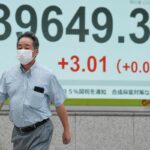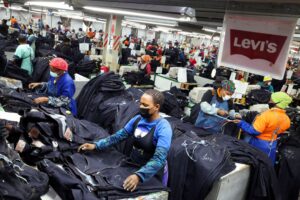
Bloomberg
Toxic Spills in Venezuela Offer a Bleak Vision of the End of Oil
(Bloomberg) — Tropical rains have washed away most outward traces of the oil spill that ravaged Rio Seco this fall. But the fishing village in the shadow of Venezuela’s main refining hub bears the scars of deeper contamination.Boats with oil-stained hulls must now travel further out into the Caribbean to make a catch. Crude has soaked the roots of nearby mangroves, leaving shrimp grounds barren. Seeing no future, dozens of fishermen and their families have fled their homes; those who are left loiter in the village, waiting for Petroleos de Venezuela, the state oil company known as PDVSA, to compensate for lost boats, equipment and sales.Broke and subject to international sanctions, President Nicolas Maduro’s government is squeezing what it can from Venezuela’s collapsing oil industry, unleashing an environmental disaster in one of Earth’s most ecologically diverse nations. As the country’s vast resources become a toxic burden, Venezuela offers a bleak vision of the end of oil in a founding OPEC member.Rio Seco is just the latest to bear the consequences, after the rupture of an offshore pipeline produced an enormous toxic geyser in the middle of local fishing grounds in September. The incident only came to light after Nelio Medina, the leader of a fishing council in the village, posted a video of the catastrophe on social media, causing an outcry.It’s far from an isolated case. In the past, it took protests to force the state oil company to act, Medina said in an interview. Fishing boats have even blocked sea lanes to the refineries — a drastic move in a country known for persecuting dissidents. Yet the desperation is real: Medina sees no end to the problems caused by decaying pipelines.“They should have replaced them a long time ago,” he said.Venezuela boasts the world’s largest known oil reserves, but it’s struggling to produce any gasoline at all as sanctions constrain crude exports that are the foundation of its economy and bar the import of parts essential for maintenance. The result is a downward spiral of spills, scarcity and yet more economic suffering that disproportionately hits the poorest of the poor — those who can’t afford to join the estimated 5 million Venezuelans who have fled to neighboring countries.A journey in November to the Paraguana peninsula that is home to PDVSA’s Cardon and Amuay refineries showed how far Venezuela has fallen. Because of endemic shortages, preparations for a round trip from the capital, Caracas, of just over 1,000 kilometers (about 620 miles) include procuring enough fuel for the route and a vehicle able to transport the necessary jerrycans.Contrasts between Venezuela’s oil-fueled glory days and today’s dereliction are everywhere. The Paraguana complex was once the largest in the world, and at the turn of the century its refineries were such dominant exporters to the U.S. that even minor production glitches often sent gasoline futures soaring. These days only two of the six produce anything at all.The complex has a processing capacity of almost 1 million barrels a day. Yet now even cooking gas is so scarce that many residents have to rely on firewood.“We don’t understand how with two such large refineries next to us we don’t have gasoline or gas,” said Reina Falcon, 69, as she prepared fish for her four grandchildren and five great-grandchildren.Falcon has seen PDVSA’s declining fortunes up close from the shores of the Amuay refinery town. Living so near to the complex, she is concerned about the health and safety of her family: A giant explosion in 2012 left at least 42 dead, and fires and blasts have become almost routine since.Spills also occur regularly, and each time Venezuela is able to dodge sanctions and export a few tanker loads — as happened when an Iranian vessel loaded crude this fall — it frees up storage space to start pumping oil through leaky pipelines. Iran’s biggest fleet of tankers yet is at sea now bound for Venezuela.Best practices went out the window two decades ago following a failed coup and nationwide strike against the late Hugo Chavez, Venezuela’s populist president who renationalized the industry and built up massive debts even during the era of $100-a-barrel oil.Prices have cratered under Maduro and brought to a head the cumulative impact of neglect, corruption and mismanagement. PDVSA was one of the most technically advanced national oil companies as recently as the late 1990s; now it’s a hollowed-out husk presiding over the industry’s demise. Venezuela’s crude production hit a low of 337,000 barrels a day in June, just 10% of the country’s peak output back in 2001. PDVSA didn’t respond to email and texted requests for comment.With global demand plummeting during the pandemic, the reality for Venezuela as elsewhere is that the world is moving on from fossil fuels. Oil-dependent economies everywhere will need billions of dollars to safely retire decades of infrastructure buildout, but in Venezuela’s case the money isn’t there and there’s little prospect of foreign aid, while the industry’s legacy stretches back a full century.“The level of neglect has been brutal,” said Raul Gallegos, a Bogota-based director at Control Risks, an international consulting firm. What’s more, the impact is only going to get worse since the Maduro government “isn’t going anywhere,” he said.Maduro, who tightened his grip on power in National Assembly elections this month and looks to have seen out the Trump administration, has expressed hope for improved U.S. relations under President-elect Joe Biden. But the prospects of a let-up in sanctions look dim. Biden criticized Trump’s push for regime change, but he also called Maduro a dictator.Venezuela exported its first barrel of oil in 1539, when records show that a shipment was sent to the Spanish court to treat Emperor Charles V’s gout. Lake Maracaibo, a Caribbean inlet the size of Connecticut, is where the industry got its real start.In 1922, Royal Dutch Shell made a discovery at Cabimas: Residents of Maracaibo some 20 miles away could see the fountain of oil on the other side of the lake from their rooftops. The giant oilfield then known as El Barroso II, later as the Costal Bolivar Complex, went on to make Venezuela the world’s top exporter by the end of the decade, a crown it held until 1970.Oil revenues fueled state-of-the-art airports and highways in the 1950s, made it a destination for immigrants from Europe and neighboring countries, and helped pave the way for a gilded era of excess. Hilton established hotels in the capital and near the Caribbean coast; Concorde flew a direct Caracas-Paris service.A century after the initial gusher, the streets of Cabimas are again soiled with crude. On Sept. 18, just a few blocks from the 1922 well site, oil bubbled up from a residential sidewalk during heavy rains and flooded several streets, according to videos and photos posted on Twitter.Ninoska Diaz, a Cabimas resident who runs a small school from her home, said that she had to send students home when the school was flooded with oil that soaked desks and chairs, forcing her to throw them out. “We don’t see any response from the government,” she said by phone.Oil spills are a chronic by-product of daily output in Venezuela, yet sanctions limit the scope for outside help even if Maduro were to seek assistance. Spills are larger and more frequent out of sight in the plains of the Orinoco River, where cattle ranches and crops are located, according to Ismael Hernandez, a remediation expert at the Central University of Venezuela. Maduro is prioritizing the region’s top fields in a last stand to maintain any output at all.Read More: Venezuela Is Tearing Apart Oil Pipelines to Sell as Scrap MetalMonitoring and evaluating spills is becoming harder because of fears of government retribution, said Alicia Villamizar, a biologist at the Simon Bolivar University in Caracas.One egregious example came in July, when oil from a PDVSA refinery spilled onto the white sand and coral reefs of the world-renowned Morrocoy national park, home to more than 1,000 marine species, many of them endangered. As a signatory of regional conventions on safeguarding the Caribbean ecosystem, Venezuela has a duty to protect the area, said Villamizar, an expert on the region’s mangroves. Instead, it left the first response to environmental groups and locals.Authorities played down the Morrocoy incident, accusing environmental groups of exaggerating the damage. Environment minister Oswaldo Barbera said in October that the park’s 25 kilometer coast had been “100%” cleaned up with “no oil to be found.” Yet the environmental damage keeps coming. The El Palito refinery west of Caracas is prone to accidents and fires due to a lack of staff and spare parts. The refinery’s waste collection pits are overflowing and spill into the Caribbean when it rains, according to people working there. The nearby beach smells of diesel. Satellite images compiled by Eduardo Klein, coordinator of the Center for Marine Biodiversity at the Simon Bolivar University, show dark outflows from the El Palito and Cardon refineries as if they were weeping oil into the Caribbean.The paradox is that the plunge in oil output has done nothing to curb Venezuela’s emissions. That’s because the industry is unable to capture and use as much gas as it did even a decade ago, so burns it off. Only the U.S., Russia, Iraq and Iran, all with far greater production, flared more gas last year, a World Bank study found.Time may now being called on Venezuela’s industry. Global oil production was cut in response to Covid-19, and Venezuela’s OPEC+ partners are restraining how fast they restore output to put a floor under prices. Russia, while a longtime Maduro ally, produces a similar grade of heavy crude and has invaded some of Venezuela’s traditional markets. Canada’s tar oil has taken others.The European oil majors that helped Venezuela develop its tar fields in the late 20th century are unlikely to return even if Biden precipitates a Maduro exit. Shell and Total are under shareholder pressure to curb emissions, and that means steering clear of the most carbon-laden grades of crude, like those of the Orinoco.Maduro remains defiant.“We’re prepared, we’ve trained, and Venezuela will not be stopped by oil at 10, nor less than 10 [dollars a barrel],” he said in April.In Rio Seco, heavy off-season rains washed much of the chronic petroleum residue off the beaches in November, granting locals some temporary relief. PDVSA has yet to even estimate damages after the spill, and officials have told the community that they are waiting on financing to be able to offer compensation.Giovanny Medina, 40, from across the gulf at Cardon, a fishing village that has managed to coexist with the refinery built by Shell in 1949, isn’t worried about competition from the displaced fishermen of Rio Seco. His chief concern is the relentless pollution that means taking his wooden skiff, known as a peñero, into deeper waters using more gasoline.“We don’t want to be painting the hulls of our boats white anymore to cover up the crude stains,” he said. “We’re tired of doing this.” For more articles like this, please visit us at bloomberg.comSubscribe now to stay ahead with the most trusted business news source.©2020 Bloomberg L.P.









